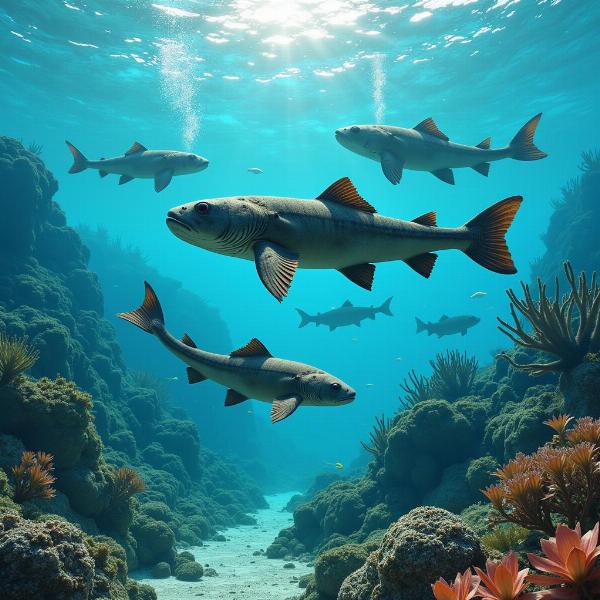Coelacanth meaning in Hindi revolves around the fascinating concept of a “living fossil.” This ancient fish, once thought extinct, continues to captivate scientists and language enthusiasts alike. Understanding its Hindi terminology delves into the rich tapestry of scientific and cultural significance surrounding this remarkable creature.
Decoding the Coelacanth: A Linguistic and Biological Exploration
The coelacanth, scientifically known as Latimeria chalumnae, holds a unique position in evolutionary history. Its rediscovery in 1938 challenged prevailing scientific understanding and sparked renewed interest in this “living fossil.” While a direct Hindi translation doesn’t exist, understanding the contextual meaning is key. Terms like “jeevant jeevasm” (जीवंत जीवाश्म) or “praacheen machhli” (प्राचीन मछली) often convey the essence of the coelacanth in Hindi, highlighting its ancient lineage and survival against the odds.
What makes the coelacanth so special? Its unique physiology, including lobed fins resembling limbs, provides valuable insights into the evolutionary transition from aquatic to terrestrial life. This evolutionary significance resonates in the Hindi language, where discussions often link the coelacanth to the broader narrative of life’s origins and development on Earth.
Coelacanth in Indian Culture and Language: A Deeper Dive
While not a prominent figure in mainstream Indian culture, the coelacanth’s existence sparks curiosity and discussion within scientific and academic circles. Its story aligns with ancient Indian philosophical concepts of resilience and adaptation, reflecting the enduring power of life. The Hindi language, with its rich vocabulary for describing natural phenomena, offers a nuanced perspective on this remarkable creature.
Dr. Anjali Sharma, a renowned marine biologist from Mumbai, emphasizes the importance of studying such “living fossils.” She states, “The coelacanth offers a unique window into the past, allowing us to understand the evolutionary processes that shaped life on Earth.” This sentiment resonates with the scientific community in India, where the coelacanth symbolizes the interconnectedness of life across millennia.
The Coelacanth’s Legacy: Preservation and Future Research
Understanding the coelacanth meaning in Hindi also encompasses the importance of its conservation. Protecting this endangered species is crucial for preserving biodiversity and understanding our planet’s evolutionary history. Professor Vijay Kumar, an expert in ecological conservation at Delhi University, adds, “The coelacanth’s survival is a testament to the resilience of nature. We must strive to protect this unique creature for future generations.”
 Coelacanth Conservation Efforts
Coelacanth Conservation Efforts
Conclusion: The Enduring Mystery of the Coelacanth
The coelacanth meaning in Hindi encompasses a wide range of scientific, cultural, and linguistic facets. From its biological significance as a “living fossil” to its symbolic representation of resilience and adaptation, the coelacanth continues to intrigue and inspire. Understanding its place within the Hindi language and Indian cultural context allows for a deeper appreciation of this extraordinary creature and its role in the grand narrative of life on Earth.
FAQ: Exploring Coelacanth Curiosities
-
What does “coelacanth” literally mean? The name comes from Greek, meaning “hollow spine,” referring to its unique fin structure.
-
Where are coelacanths found? They inhabit deep-sea environments in the Indian Ocean and off the coast of Indonesia.
-
What do coelacanths eat? They are primarily piscivorous, feeding on other fish and cephalopods.
-
Are coelacanths endangered? Yes, both known species of coelacanth are listed as either vulnerable or critically endangered.
-
Why is the coelacanth called a “living fossil”? Because it represents a lineage of fish thought to have been extinct for millions of years.
-
How big do coelacanths get? They can grow up to 6.5 feet long and weigh over 200 pounds.
-
What is the significance of the coelacanth’s lobed fins? They are believed to be an evolutionary link between fish fins and the limbs of terrestrial vertebrates.
Meaning-Hindi.in provides expert translation services specializing in various fields, including technical, legal, and academic document translation. Our expertise in Hindi and other Indian languages ensures accurate and culturally sensitive translations for businesses, individuals, and organizations. From business documents to educational materials, Meaning-Hindi.in delivers high-quality translation solutions tailored to your specific needs. Contact us today for all your Hindi translation requirements: Email: [email protected], Phone: +91 11-4502-7584. Connect with Meaning-Hindi.in for seamless communication across cultures.